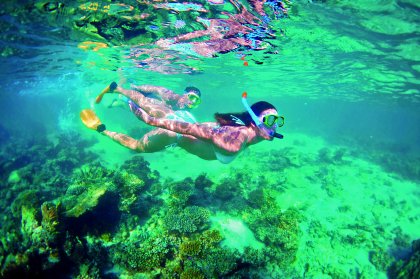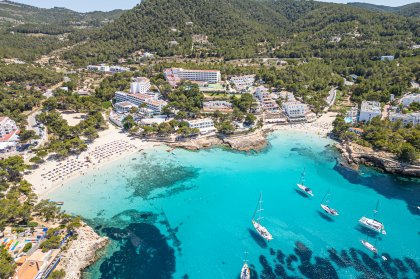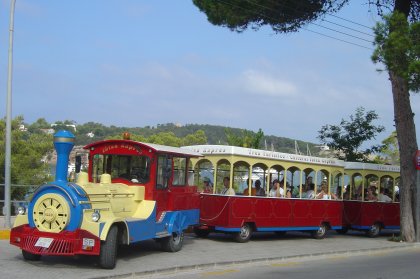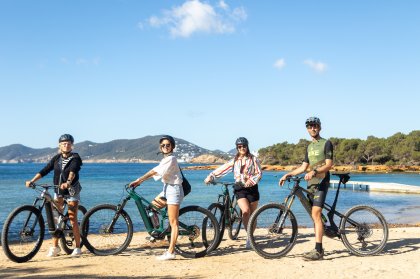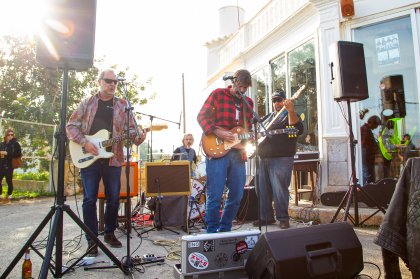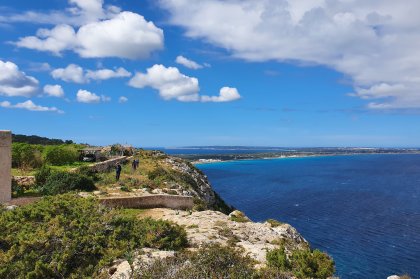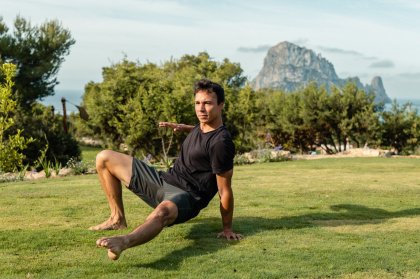One of the finest qualities of the island is its stunning natural beauty and its long history of attracting different invading cultures to the island, from the Phoenicians, the Visigoths, the Moors and more recently the Catalans from across the sea – all of whom left a lasting impression on the architecture and landscape of this pretty Balearic isle.
If you choose to stay in pretty much one place for the duration of your stay and aren’t hiring a car, you’ll miss out on many of the treasures the island has to offer. There is an easier way to see more, via the cute little tourist trains that do routes around the island. Priced at €16 for adults and €8 for children with under-three’s free, it’s good value for an information-packed 3-hour journey. The Ibiza Express is one of these and runs several guided excursions in the north of the island so you can sit back, take in the views and listen to the commentary as you ride along.
Excitement and adventure

There are tours of San Carlos, Santa Eulalia, Es Canà, San Miguel and Portinatx. Having never really visited the far north of the island enough to do it justice, we decided on the Portinatx trip to see a bit of the rural Ibicencan life as a big mixed group of parents, grandparents and kids. The first thing to point out is that this is not an actual train that runs on tracks: there aren’t any on Ibiza. What you get is a cheeky, brightly coloured mini-train that runs on wheels. I do admit to having a childish kind of excitement getting on board of this chap, which must stem from my love of Thomas the Tank Engine as a kid or was that just Ringo Starr?
As we set off at a reasonable pace, you leave the pretty town of Portinatx and are led through the pine-clad hillsides with some stunning views of the Xarraca coastline. We passed lots of beautiful old finca-style buildings and the fields with the almond and carob trees that seem to be dotted everywhere across the island. The commentary highlights not just the views but gives you an insight into Ibiza’s past before all the roads connecting the towns were built. We learned about why the Phoenicians called Ibiza and Formentera the ‘pitiusas’ islands too - they were covered in pine trees, unsurprisingly the name endures. I’d heard of Posidonia, the sea grass that is endemic to the Mediterranean sea, but knew little about it. Around Ibiza there are vast meadows of it, supporting a vast variety of marine life; it only grows in clean waters and the abundance of it around the island is testament to the continued purity of the sea. Long may that continue!
Superb ancient caves

We carried on to our first stop by the pretty port of San Miguel, which is just breathtaking, taking you by surprise as you emerge from a long-winding road. There’s even a small island off it, complete with it’s own James Bond style house, which until recently was for sale. I didn’t ask the price. We stopped to take a look at the 1,000-year-old caves of Can Marça, an optional part of the trip since you pay extra for this. There are a few steep steps to get down to it and navigate through the caves, so if mobility is an issue there’s a café at the top for a coffee or even a G&T.
The caves are simply superb and the guide is multi-lingual and takes you through the all the history of the caves. They used to be used by smugglers bringing in bootleg tobacco and alcohol and it was clear that they were all slim-hipped and thin, since getting in and out from the small access passages would have been a job in itself. The stalagmites and stalactites grow just 1cm every 100-years, so when you see the size of these in their pretty formations, there’s a real sense of awe for the length of time required to create them. Half way through there’s a music and light show with an inside waterfall, which everyone loved and they add phosphorescent colour to the little rock pools so you can appreciate their beauty in the darkness.
Carobs, figs and cattle

So it was all aboard for our final trip to San Juan the ‘capital’ to visit the pretty, though slightly austere church in San Juan. After this, we boarded for the final leg of the trip back to where we started, learning about the fruit of the carob and how the seeds used to be used to weigh diamonds in carats. Another interesting factoid is that fig trees in Ibiza were (and still are) used as a kind of shelter for animals, with their branches propped up to shield cattle from the heat and for them to eat at the fruit to keep them fed. It’s a must spot item in my list now.
We left having learned lots and eager to find out more detail of what we had been told. If you want to while away the time without having to think too hard, whilst learning some interesting facts, this train trip is just the ticket.
Please click here for more information and to book tickets.
WORDS | Julian Heathcote
